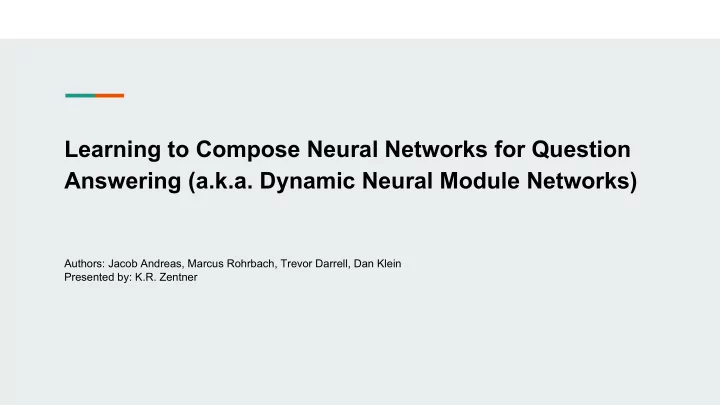

Learning to Compose Neural Networks for Question Answering (a.k.a. Dynamic Neural Module Networks) Authors: Jacob Andreas, Marcus Rohrbach, Trevor Darrell, Dan Klein Presented by: K.R. Zentner
Basic Outline Problem statement ● Brief review of Neural Module Networks ● New modules ● Learned layout predictor ● Some minor additions ● Results ● Conclusion ●
Problem Statement Would like to have a single algorithm for a variety of question answering domains. More precisely, given a question q and a world w , produce an answer y . q is a natural language question, y is a label (or boolean), w can be visual or semantic. Would like to work well with a small amount of data, but still benefit from significant amounts of data.
Neural Module Networks Answer a question over an input (image only), in two steps: 1. Layout a network from the question. 2. Evaluate the network on the input.
Neural Module Networks Two large weaknesses: 1. What if we don’t have an image as input? 2. What if dependency parsing results in a bad network layout?
What if we don’t have an image as input?
Replace Image with “World” The “World” is an arbitrary set of vectors. ● Still use attention across the vectors. ● Treat image as world by operating after the CNN. ● NMN modules assume CNN / Image! ●
New Modules! Neural Module Network Dynamic Neural Module Network attend[word] : Image → Attention find[word] : (World) → Attention lookup[word] : () → Attention re-attend[word] : Attention → Attention relate[word] : (World) Attention → Attention combine[word] : Attention x Att. → Attention and : Attention* → Attention classify[word] : Image x Attention → Label describe[word] : (World) Attention → Labels measure[word] : Attention → Label exists : Attention → Labels
Attend → Find Neural Module Network Dynamic Neural Module Network attend[word] : Image → Attention find[word] : (World) → Attention “An MLP:” softmax(a ๏ σ(Bv i ⊕ CW ⊕ d)) A convolution. attend[dog] find[dog] or find[city] Generates an attention over the Image . Generates an attention over the World .
“ “ → Lookup Neural Module Network Dynamic Neural Module Network lookup[word] : () → Attention A know relation: e f(i) lookup[Georgia] For words with constant attention vectors.
Re-attend → Relate Neural Module Network Dynamic Neural Module Network re-attend[word] : Attention → Attention relate[word] : (World) Attention → Attention softmax(a ๏ σ(Bv i ⊕ CW ⊕ Dw(h) ⊕ e)) (FC → ReLU) x 2 re-attend[above] relate[above] or relate[in] Generates a new attention over the Image . Generates a new attention over the World .
Combine → And Neural Module Network Dynamic Neural Module Network combine[word] : Attention x Att. → Attention and : Attention* → Attention h1 ๏ h2 ๏ … Stack → Conv. → ReLU combine[except] and Combines two Attentions in an arbitrary Multiplies attentions (analogous to set way. intersection).
Classify → Describe Neural Module Network Dynamic Neural Module Network classify[word] : Image x Attention → Label describe[word] : (World) Attention → Labels Attend → FC → Softmax softmax(Aσ(Bw(h) + vi)) classify[where] describe[color] or describe[where] Transforms an Image and Attention into a Transforms a World and Attention into a Label. Label.
Measure → Exists Neural Module Network Dynamic Neural Module Network measure[word] : Attention → Label exists : Attention → Labels FC→ ReLU → FC → Softmax softmax((argmax h) a + b) measure[exists] exists Transforms just an Attention into a Label. Transforms just an Attention into a Label.
What if dependency parsing results in a bad network layout?
New layout algorithm! NMN Dynamic-NMN Dependency parse Dependency parse ● ● Leaf → attend Proper nouns → lookup ○ ○ ○ Internal (arity 1) → re-attend ○ Nouns & Verbs → find Internal (arity 2) → combine Prepositional phrase → relate + find ○ ○ Generate candidate layouts from subsets of ○ Root (yes/no) → measure ● Root (other) → classify ○ fragments. Layout of network strictly ● and all fragments in subset ○ follows structure of dependency ○ measure or combine parse tree. “Rank” layouts with structure predictor. ● Use highly ranked layout. ●
New layout algorithm! Only possible because “and” module has no parameters. Structure predictor doesn’t have any direct supervision. How can we train it?
Structure Predictor? Computes h_q(x) by passing LSTM over question. Computes featurization f(z_i) of ith layout. Sample layout with probability p(z_i | x; 𝜄 _l) = softmax(a ・ σ(B h_q(x) +C f(z_i) +d))
How to train Structure Predictor? Use a gradient estimate, as in REINFORCE (Williams, 1992). Want to perform an SGD update with ∇ J( 𝜄 _l). Estimate ∇ J( 𝜄 _l) = E[ ∇ log p(z | x ; 𝜄 _l) ・ r] Use reward r = log p(y | z, w; 𝜄 _e) Step in direction ∇ log p(z | x ; 𝜄 _l) ・ log p(y | z, w; 𝜄 _e) With small enough learning rate, estimate should converge.
New Dataset: GeoQA (+ Q) Entirely semantic: database of relations. ● Very small: 263 examples. ● (+ Q) adds quantification questions (e.g. ● What cities are in Texas? → Are there any cities in Texas?) State of the art results. ● Compared to 2013 baseline and NMN. ○
Old Dataset: VQA Need to add “passthrough” to final hidden ● layer. Once again uses pre-trained VGG network. ● Slightly improved state of the art. ●
Weaknesses? Can only generate very flat layouts, with only one conjunction or quantifier. ● Gradient estimate probably much more expensive / unstable than true gradient. ● Not any simpler than NMN, which are already considered complex. ● Similar in spirit but not implementation to Neural Symbolic VQA (Yi et. al. 2018). ● Much more complex than Relation Networks (Santoro et. al. 2017). ●
Questions? Discussion.
Recommend
More recommend